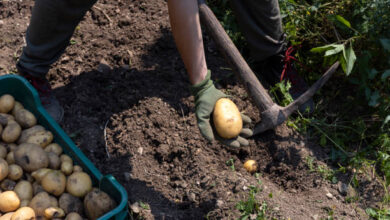
Organic Sweet Potatoes: All You Need To Know
Organic sweet potatoes are a nutritious and delicious addition to any garden. Growing them organically not only supports sustainable practices but also yields flavorful and healthful produce. Whether you’re a seasoned gardener or a beginner, this guide will walk you through everything you need to know about planting, caring for, and enjoying organic sweet potatoes.
What Are Organic Sweet Potatoes and Why Choose Them?
Characteristics of Organic Sweet Potatoes: Organic sweet potatoes are grown without synthetic pesticides or fertilizers, ensuring that the final produce is free from harmful chemicals. They typically have a sweeter taste and a richer nutrient profile compared to conventionally grown sweet potatoes. These tubers come in various colors, including orange, purple, and white, each offering unique flavors and textures.
Benefits of Organic Sweet Potatoes:
– Healthier Choice: Organic sweet potatoes are often richer in nutrients and free from chemical residues, making them a healthier option for you and your family.
– Environmental Impact: Growing organically helps maintain soil health, reduces water pollution, and supports biodiversity. Organic farming practices also help conserve natural resources and promote ecological balance.
– Superior Flavor: Many gardeners and chefs believe that organic sweet potatoes have a superior taste and texture compared to their conventionally grown counterparts.
Varieties of Organic Sweet Potatoes:
– ‘Beauregard’: Known for its high yield and excellent flavor, ‘Beauregard’ has a reddish skin and orange flesh.
– ‘Covington’: A variety with deep orange flesh and a sweet, creamy texture. It’s highly resistant to diseases and pests.
– ‘Japanese Sweet Potato’: Features a reddish-purple skin and creamy, sweet flesh. This variety is known for its rich, nutty flavor.
How to Plant Organic Sweet Potatoes for a Successful Harvest
Best Time to Plant: The ideal time to plant organic sweet potatoes is in late spring or early summer, after all danger of frost has passed and the soil temperature is consistently above 60°F (15°C). Sweet potatoes require a long growing season, so plan to plant them a few weeks before the last expected frost.
Soil Preparation:
– Soil Type: Sweet potatoes prefer well-drained, sandy loam or loamy soil. Heavy clay soils can lead to poor tuber development.
– pH Level: Aim for a soil pH between 5.8 and 6.2. You can test and amend your soil using organic methods such as lime to raise pH or sulfur to lower it.
– Organic Matter: Incorporate compost or well-rotted manure into the soil to improve fertility, structure, and drainage.
Planting Instructions:
– Planting Slips: Organic sweet potatoes are typically started from “slips,” which are young plants grown from mature sweet potato tubers. Purchase organic slips or grow your own from organic tubers.
– Spacing: Space slips 12 to 18 inches apart in rows that are 3 to 4 feet apart. This spacing allows for the sprawling growth habit of sweet potato vines.
– Planting Depth: Plant slips deep enough to cover the roots and the base of the stem. Ensure that the slip is well-rooted in the soil.
– Watering: Water the slips thoroughly after planting and keep the soil consistently moist but not waterlogged. Proper watering is crucial for successful tuber development.
Container vs. Garden Planting:
– Containers: Sweet potatoes can be grown in large containers or raised beds with well-draining soil. Ensure containers have drainage holes and use a high-quality potting mix.
– Garden Beds: In garden beds, choose a sunny location with loose, well-drained soil. Raised beds can also be an excellent option for better control over soil quality.
Essential Care Tips for Healthy Organic Sweet Potato Growth
Watering Requirements: Sweet potatoes need consistent moisture, especially during the tuber formation period. Water deeply once a week, ensuring the soil remains evenly moist. Avoid overhead watering to reduce the risk of fungal diseases.
Fertilization: Organic sweet potatoes benefit from organic fertilizers such as compost, fish emulsion, or seaweed extract. Apply a balanced organic fertilizer at planting and again when the vines start to grow vigorously. Avoid excessive nitrogen, which can lead to lush foliage but poor tuber development.
Light and Temperature: Sweet potatoes thrive in full sun, requiring at least 6 to 8 hours of sunlight per day. They prefer temperatures between 70°F and 85°F (21°C to 29°C). If growing in cooler climates, use row covers or cloches to retain warmth.
Maintenance Practices:
– Weed Control: Keep weeds in check, as they can compete with sweet potatoes for nutrients and water. Mulch around the plants to suppress weed growth and retain soil moisture.
– Mulching: Apply organic mulch such as straw or leaves around the plants to regulate soil temperature and moisture levels.
– Pest Management: Monitor for common pests like sweet potato weevils and aphids. Use organic pest control methods such as neem oil or insecticidal soap if needed.
YOU MAY LOVE TO READ
Huckleberry Gold Potatoes: A Culinary Treasure
Mint Seeds: Everything You Have To Know
When to Plant Potatoes in Texas: The Ultimate Guide.
Troubleshooting Organic Sweet Potato Problems
Pests and Diseases:
– Pests: Sweet potato weevils, aphids, and nematodes can affect plants. Introduce beneficial insects, such as ladybugs, and use organic pest control methods to manage infestations.
– Diseases: Common diseases include Fusarium wilt and white mold. Practice crop rotation, use disease-resistant varieties, and ensure good air circulation to minimize disease risk.
Growth Challenges:
– Poor Tuber Formation: Ensure adequate spacing and proper soil conditions. Over-fertilization with nitrogen can also lead to poor tuber development.
– Yellowing Leaves: This can indicate nutrient deficiencies or overwatering. Check soil moisture and nutrient levels, and adjust care practices as needed.
Environmental Factors:
– Drought: Sweet potatoes are somewhat drought-tolerant but benefit from consistent moisture. Water deeply during dry periods to support tuber growth.
– Soil Conditions: Improve heavy or clay soils with organic matter to enhance drainage and prevent tuber rot.
How to Harvest and Enjoy Organic Sweet Potatoes
Harvesting Tips: Harvest sweet potatoes when the leaves start to yellow and die back, typically 90 to 120 days after planting. Carefully dig up the tubers using a garden fork or shovel, taking care not to damage them.
Storage: Cure harvested sweet potatoes by placing them in a warm, humid environment for 10 to 14 days. Store cured tubers in a cool, dark, and dry place, ideally at temperatures between 55°F and 60°F (13°C to 15°C). Proper storage extends shelf life and enhances flavor.
Culinary Uses: Organic sweet potatoes are incredibly versatile. Enjoy them roasted, mashed, baked, or in soups and stews. Their natural sweetness makes them a delicious addition to both savory and sweet dishes.
Conclusion
Growing organic sweet potatoes is a fulfilling and sustainable way to enjoy fresh, nutritious produce. By following these tips on planting, care, and harvesting, you can achieve a bountiful crop and experience the many benefits of organic gardening. Start your journey to growing organic sweet potatoes today and savor the rewards of your efforts.




